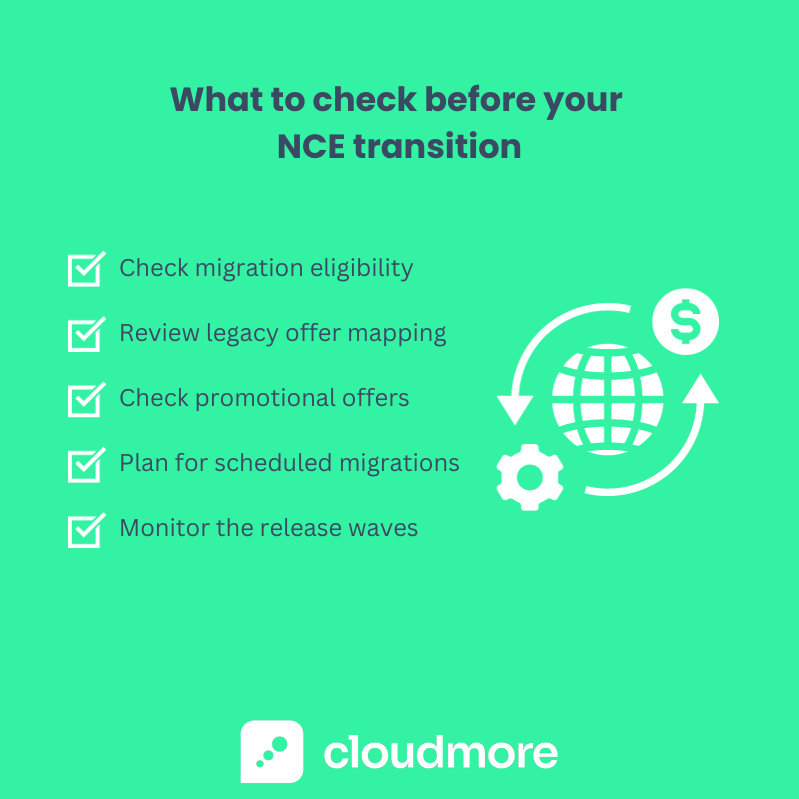Microsoft NCE Transition for the Public Sector Segment in 2024
In 2024, the public sector embarks on a transformative journey with Microsoft's New Commerce Experience (NCE).
For Microsoft partners and public sector organizations, understanding this transition is essential.
This article serves as your comprehensive guide to the NCE transition.
Understanding the Transition
The transition to Microsoft's NCE marks a pivotal change, particularly for public sector entities. Here, we delve into what this shift means for education, nonprofit, and government community cloud (GCC) customers.
The Launch of NCE for Public Sector
NCE redefines how public sector organizations access and manage Microsoft's cloud-based services. Tailored to meet the unique demands of the public sector, including educational institutions, nonprofits, and GCC entities, NCE brings a unified and simplified approach to licensing and service management.
Commencing March 1, 2024, the public sector will experience the rollout of NCE in a series of phased releases. These waves, scheduled to begin with high-volume offers and followed by others in the subsequent months, are designed to ensure a smooth and structured transition.
This planned, staggered introduction allows public sector entities to adapt progressively to the new system, ensuring minimal disruption and maximum alignment with their specific operational needs
Timeline of Key Events
The transition to NCE for the public sector will unfold in a series of carefully planned release waves. These waves are crucial for a smooth transition, ensuring each sector adequately prepares for the changes.
- Wave 1 & 2: March 1, 2024: The inaugural wave sets the stage for the transition, focusing on the most anticipated and high-volume offers.
- Wave 3: April 1, 2024: The third wave expands the reach of NCE, adding more offers tailored to the specific needs of public sector clients.
- Wave 4: May 1, 2024: The last set of public sector offers will be integrated into the NCE in this final announced wave.
.png?width=799&height=799&name=NCE%20Transition%20Timeline%20(2).png)
The significance of these release waves lies in their strategic scheduling. By staggering the introduction of NCE, Microsoft ensures that public sector clients can adapt to the new system in a manageable and phased manner.
This approach minimizes disruption while enabling organizations to efficiently align their operations with the new commerce experience. Each wave represents a step towards a more streamlined and modern approach to managing Microsoft's cloud services, catering to the unique demands of public sector entities
Preparing for Migration
The migration to Microsoft's NCE for the public sector requires careful planning and execution. Here's what you need to know to ensure a seamless transition from legacy offers to NCE.

Migration Process
- Review Legacy Offers: Examine current legacy offers and how they map to the new NCE product SKUs
- Check Eligibility for Migration: Ensure that your existing offers are eligible for migration to NCE, as not all legacy offers have a direct NCE equivalent
- Check potential promotional offers: Customers who meet the Nonprofits Grants & Credits Eligibility requirements could be eligible for promotional offers. These provide a 16.67% discount to nonprofit customers who choose to start in new commerce with a low-risk monthly commitment to any of the listed products.
- Utilize the NCE Mapping Tab: The NCE Mapping tab in the legacy offer matrix provides essential insights, including details on compatible product SKUs for migration-supported offers
- Plan for Scheduled Migrations: Microsoft-led migration will commence with offers renewing as of July 1, 2024, giving partners ample time to transition their customers
- Understand Product SKU Release Waves: Familiarize yourself with the phased release of public sector product SKUs starting from March 1, 2024
Role of Microsoft Partners
The role of Microsoft partners is pivotal in ensuring a smooth transition to NCE for public sector clients.
- Strategic Planning and Support: As a partner, your involvement in planning and executing the migration process is crucial. Your expertise will help public sector clients understand the changes and adapt their subscription strategies accordingly.
- Managing the Seven-Day Window: After the automatic migration by Microsoft, partners have a seven-day window to modify subscription terms or cancel subscriptions if necessary. This critical period allows for last-minute adjustments to align with client needs and preferences.
This migration process mirrors commercial migrations, albeit with specific considerations for the public sector.
By staying informed and proactive, Microsoft partners can play a crucial role in guiding their public sector clients through these changes, ensuring the transition to NCE is as smooth and beneficial as possible.
Key Considerations for Public Sector Clients
As public sector entities prepare for the transition to NCE, there are several critical factors to consider. These considerations are pivotal in ensuring that the move to NCE aligns seamlessly with the unique operational dynamics of the public sector.
Budget and User Fluctuation
- Strategic Budget Planning: With NCE, annual commitments become a central part of the subscription model. Public sector organizations must strategically budget, aligning their subscription choices with their fiscal plans. Accurate forecasting and budget allocation will be vital to managing costs effectively under the new NCE structure.
- Managing User Fluctuations: Public sector entities often experience significant fluctuations in user numbers. This variability can be due to seasonal staffing changes, project-based work, or academic calendars. Structuring licenses to accommodate these fluctuations will be essential. Balancing annual subscriptions for a stable user base against more flexible monthly subscriptions for temporary users can offer an optimized solution.
Security and Compliance
Cybersecurity remains a top priority in the public sector, where protecting sensitive data is paramount. The shift to NCE presents an opportune moment to reassess and enhance security measures.
- Enhancing Security Measures: The migration to NCE is an excellent opportunity for public sector organizations to review and upgrade their cybersecurity posture. Transitioning to modern, secure Microsoft SKUs can help safeguard against vulnerabilities and enhance overall security compliance.
- Compliance with Regulations: NCE also aligns with the latest compliance standards, ensuring that public sector clients meet regulatory requirements while benefiting from the latest technological advancements.
- Microsoft Plan Simplification: Microsoft will change their 'Cloud for Nonprofit' plans, shifting from a two-plan model to a single plan (available at no additional cost), allowing customers to be both an education and nonprofit simultaneously.
Microsoft and Partner Support
Navigating the transition to NCE requires guidance and support, both from Microsoft and its partners.
- Microsoft's Role: Microsoft provides extensive resources and support to facilitate the transition. This includes detailed guidance on migration processes, subscription management, and compliance with new policies.
- Partner Involvement: As a Microsoft partner, your role in assisting public sector clients through this transition is invaluable. Your expertise and understanding of NCE can help clients adapt their strategies, manage their subscriptions effectively, and fully leverage the benefits of the new system.
By addressing these fundamental considerations, public sector clients can effectively prepare for the transition to NCE, ensuring that their move aligns with budgetary requirements, user needs, security protocols, and compliance standards. With the proper planning and support, the transition to NCE can be a step forward in optimizing and securing their digital infrastructure.
Key Takeaways for the NCE Transition in 2024
As we approach the pivotal transition to Microsoft's NCE in 2024, it's essential to consolidate our understanding and prepare for the changes ahead. Here are the key takeaways to ensure a smooth transition for public sector organizations and Microsoft partners:
- Strategic Approach to Transition: The phased rollout of NCE starting March 1, 2024, calls for a strategic and well-planned approach. Understanding the specifics of each wave and aligning your organization's transition plan with these phases is crucial.
- Importance of Budgeting and Planning: Given the annual commitments inherent in NCE, precise budgeting and license planning are more important than ever. Public sector entities should align their subscription choices with fiscal plans, considering user fluctuations and seasonal staffing changes.
- Cybersecurity and Compliance Focus: The transition to NCE is an opportune time to strengthen cybersecurity measures. Embrace this change to upgrade security protocols and ensure compliance with the latest standards, safeguarding sensitive public sector data.
- Partner Involvement and Support: Microsoft partners play a vital role in facilitating this transition. Your expertise and support will be essential in helping public sector clients understand the changes, adapt their strategies, and manage their subscriptions effectively.
- Embrace the Change: Transitioning to NCE is more than just a procedural shift; it's a step towards modernizing and streamlining operations. Embrace the opportunities that NCE brings in terms of flexibility, efficiency, and enhanced service management.
- Stay Informed and Prepared: Continuous learning and staying updated with the latest information from Microsoft will be crucial. Utilize the resources and training provided by Microsoft to navigate these changes effectively.
In summary, the transition to NCE in 2024 is a significant milestone, offering new opportunities for growth and efficiency.
By being proactive, well-informed, and strategic, both Microsoft partners and public sector organizations can navigate this transition smoothly, positioning themselves for success in a rapidly evolving digital landscape.
Share this
You May Also Like
These Related Stories

Microsoft New Commerce Experience: A Complete Guide

Remove Azure Plan Billing Complexities With Cloudmore



